Creating a Test Plan - FCC 2.4G
Basic Settings:
WiFi
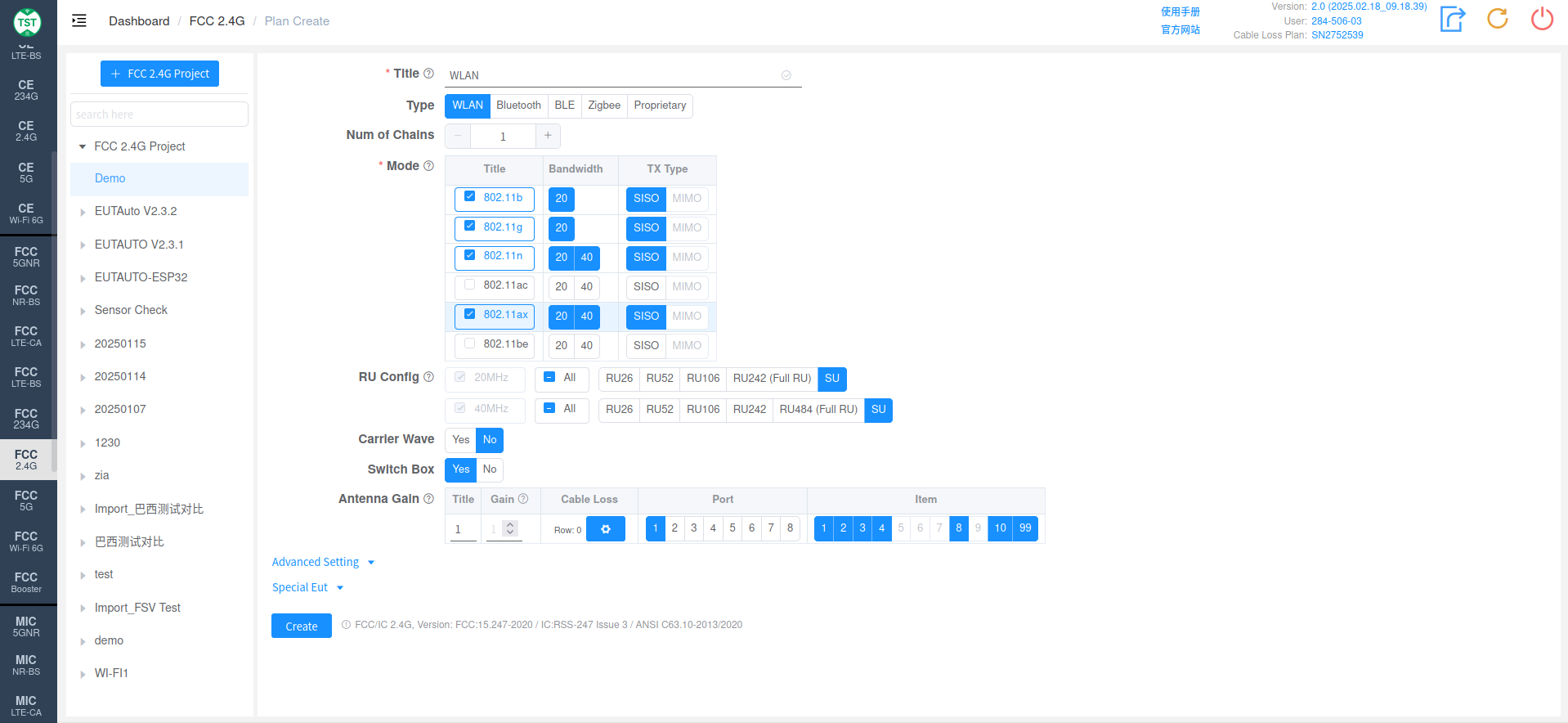
Type: Technical Category, WiFi
Num of Chains: Number of transmit chains (antennas) the product has.
Mode: Modes supported by the product, e.g., 802.11b/g/n/ax... for WiFi, or GFSK, 8DPSK, etc. for Bluetooth.
RU Config: RU configuration supported by 802.11ax devices. Full RU for each bandwidth is mandatory; other RU configurations should be selected based on the product's actual support.
Carrier Wave: Whether the product supports carrier wave transmission. If Yes is selected, the frequency error will be measured using carrier mode, and the test setup will be significantly different from modulated signal testing.
Switch Box: Whether to use a Switch Box. If a Switch Box has not been purchased, select No for this item, and the product will be directly connected to the spectrum analyzer for testing.
Antenna Gain:
Title: Antenna number, named sequentially by default as 1, 2, 3, 4..., or manually input other names according to customer requirements.
Gain: Gain of each antenna in the corresponding frequency band.
Cable Loss: Cable loss of the RF cable from the product's antenna port to the Switch Box (RF port of the switch) or SA (Spectrum Analyzer, if not using a switch directly). How to Create Common Cable Loss.
Port: Port number of the switch connected to the product's antenna, e.g., Ant1 connected to port 1, Ant2 connected to port 2.
Item: List of all test items included in this standard. *For known product types such as WIFI, Bluetooth, BLE, Zigbee, etc., the software has selected the default required test items based on their respective technical characteristics. Of course, you can also select some items for testing according to your testing needs. Note: In some standards, test parameters are mutually referenced between items. If only some items are checked, the test may not be able to proceed. Therefore, it is recommended to create a test plan using the default items directly. For multi-antenna products, to reduce workload, the first antenna will by default perform tests for all applicable items. However, other antennas have had some mandatory test items selected according to standard requirements. For non-mandatory items, you can check them yourself as needed.
Bluetooth
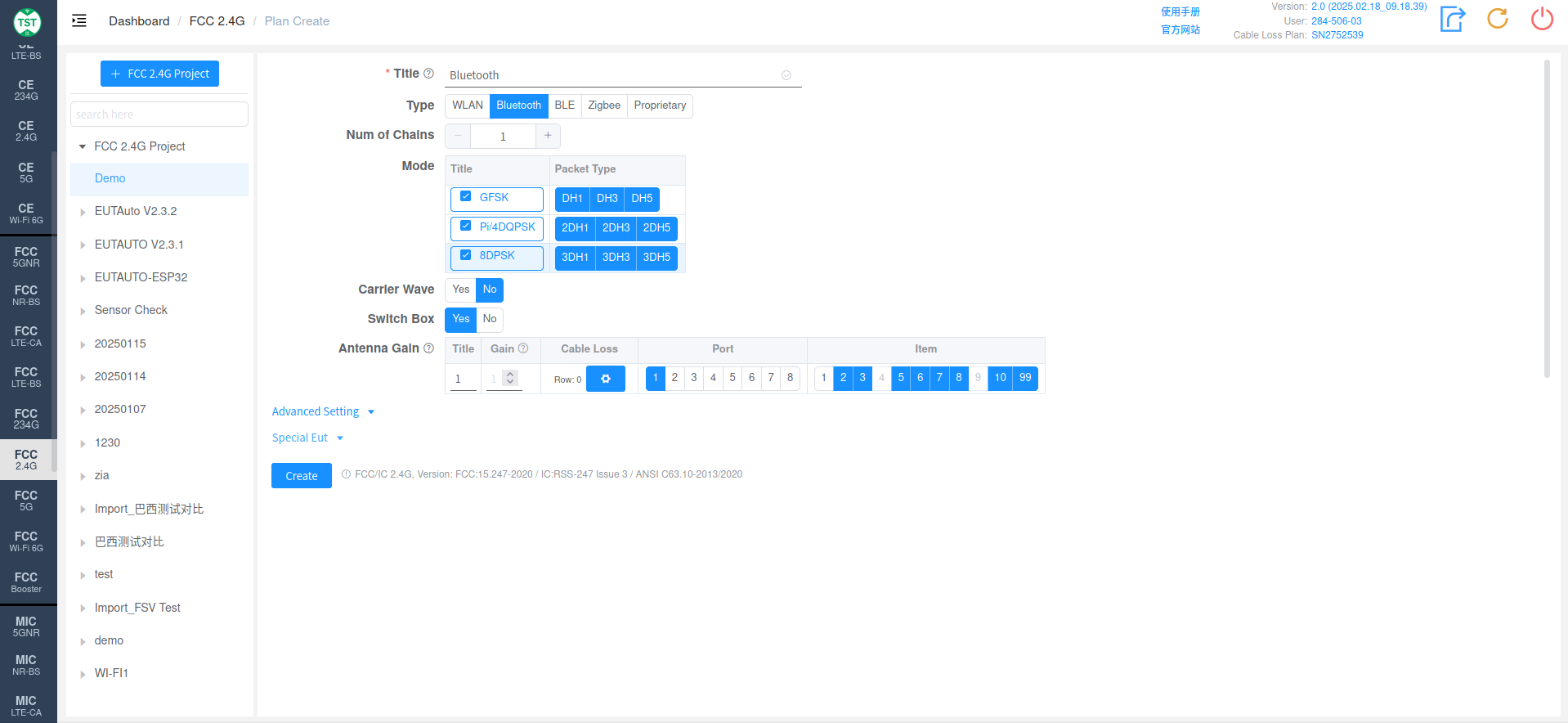
Type: Technical Category, Bluetooth
Num of Chains: Number of transmit chains (antennas) the product has. Bluetooth currently only supports single antenna.
Mode: Modes and Packet Types supported by the product.
Carrier Wave: Whether the product supports carrier wave transmission. If Yes is selected, the frequency error will be measured using carrier mode, and the test setup will be significantly different from modulated signal testing.
Switch Box: Whether to use a Switch Box. If a Switch Box has not been purchased, select No for this item, and the product will be directly connected to the spectrum analyzer for testing.
Antenna Gain:
Title: Antenna number, named sequentially by default as 1, 2, 3, 4..., or manually input other names according to customer requirements.
Gain: Gain of each antenna in the corresponding frequency band.
Cable Loss: Cable loss of the RF cable from the product's antenna port to the Switch Box (RF port of the switch) or SA (Spectrum Analyzer, if not using a switch directly). How to Create Common Cable Loss.
Port: Port number of the switch connected to the product's antenna, e.g., Ant1 connected to port 1, Ant2 connected to port 2.
Item: List of all test items included in this standard. *For known product types such as WIFI, Bluetooth, BLE, Zigbee, etc., the software has selected the default required test items based on their respective technical characteristics. Of course, you can also select some items for testing according to your testing needs. Note: In some standards, test parameters are mutually referenced between items. If only some items are checked, the test may not be able to proceed. Therefore, it is recommended to create a test plan using the default items directly. For multi-antenna products, to reduce workload, the first antenna will by default perform tests for all applicable items. However, other antennas have had some mandatory test items selected according to standard requirements. For non-mandatory items, you can check them yourself as needed.
BLE
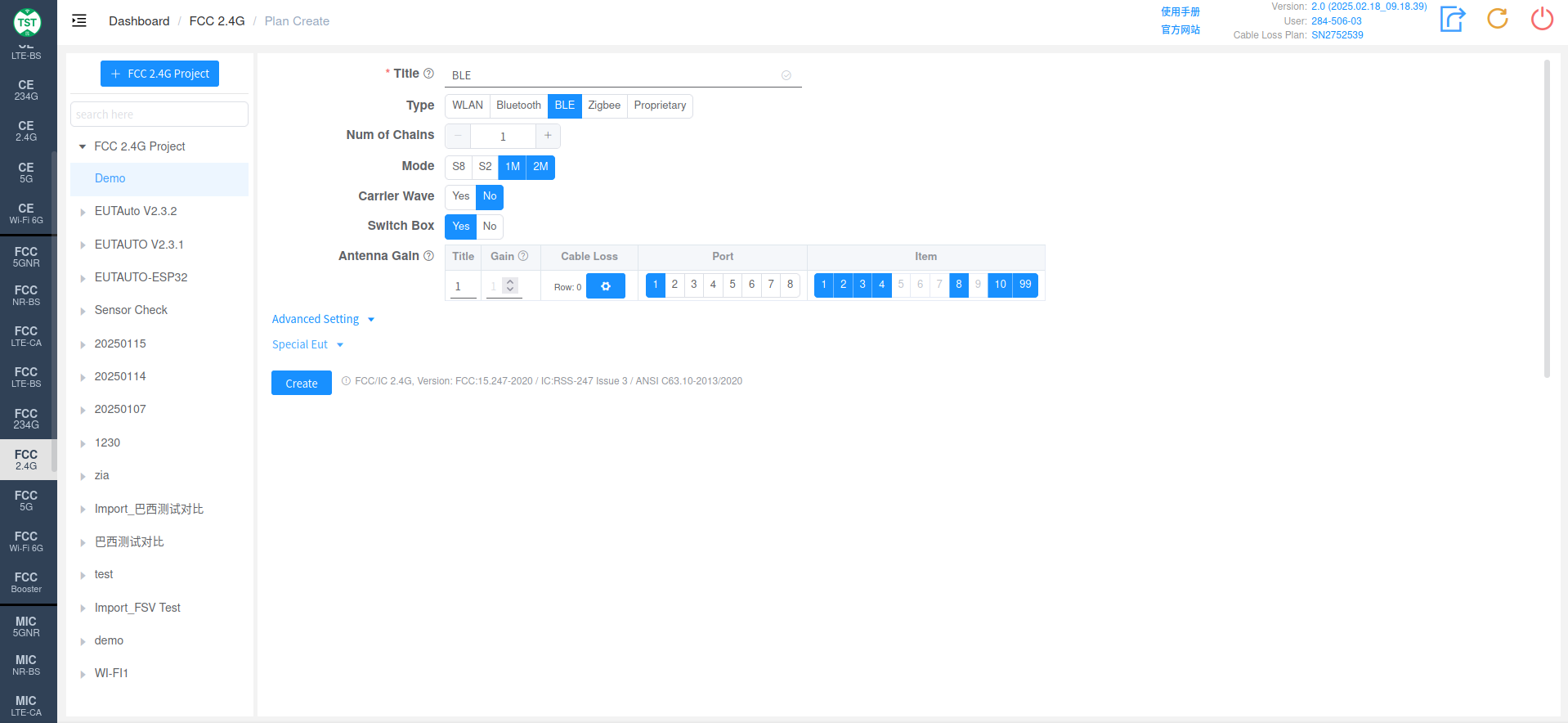
Type: Technical Category, BLE
Num of Chains: Number of transmit chains (antennas) the product has. BLE currently only supports single antenna.
Mode: Modes supported by the product. *In protocol versions prior to BT 5.0, BLE only had a 1Mbps rate. However, starting with version 5.0, in addition to retaining the 1Mbps rate, two new rates for Long range scenarios, S8 and S2 (corresponding to 125kbps and 512kbps respectively), and a 2Mbps rate for high-bandwidth scenarios were introduced for IoT products. Among these, the 1Mbps rate is mandatory for version 5.0 and above, while the other three rates are optional. In addition, the S8 and S2 rates are implemented by adding FEC (Forward Error Correction) functionality on top of the 1Mbps rate, and their symbol rate is still 1Mbps. Therefore, from the actual test results, the test results of the S8, S2, and 1M modes are basically the same. Therefore, for products that support these three rates simultaneously, generally only the 1M mode is tested. (If only the 1M mode needs to be tested, just select the 1M mode. If all three modes, S8, S2, and 1M, are selected, the software will test these three modes separately.)
Carrier Wave: Whether the product supports carrier wave transmission. If Yes is selected, the frequency error will be measured using carrier mode, and the test setup will be significantly different from modulated signal testing.
Switch Box: Whether to use a Switch Box. If a Switch Box has not been purchased, select No for this item, and the product will be directly connected to the spectrum analyzer for testing.
Antenna Gain:
Title: Antenna number, named sequentially by default as 1, 2, 3, 4..., or manually input other names according to customer requirements.
Gain: Gain of each antenna in the corresponding frequency band.
Cable Loss: Cable loss of the RF cable from the product's antenna port to the Switch Box (RF port of the switch) or SA (Spectrum Analyzer, if not using a switch directly). How to Create Common Cable Loss.
Port: Port number of the switch connected to the product's antenna, e.g., Ant1 connected to port 1, Ant2 connected to port 2.
Item: List of all test items included in this standard. *For known product types such as WIFI, Bluetooth, BLE, Zigbee, etc., the software has selected the default required test items based on their respective technical characteristics. Of course, you can also select some items for testing according to your testing needs. Note: In some standards, test parameters are mutually referenced between items. If only some items are checked, the test may not be able to proceed. Therefore, it is recommended to create a test plan using the default items directly. For multi-antenna products, to reduce workload, the first antenna will by default perform tests for all applicable items. However, other antennas have had some mandatory test items selected according to standard requirements. For non-mandatory items, you can check them yourself as needed.
Zigbee
Basic Settings:
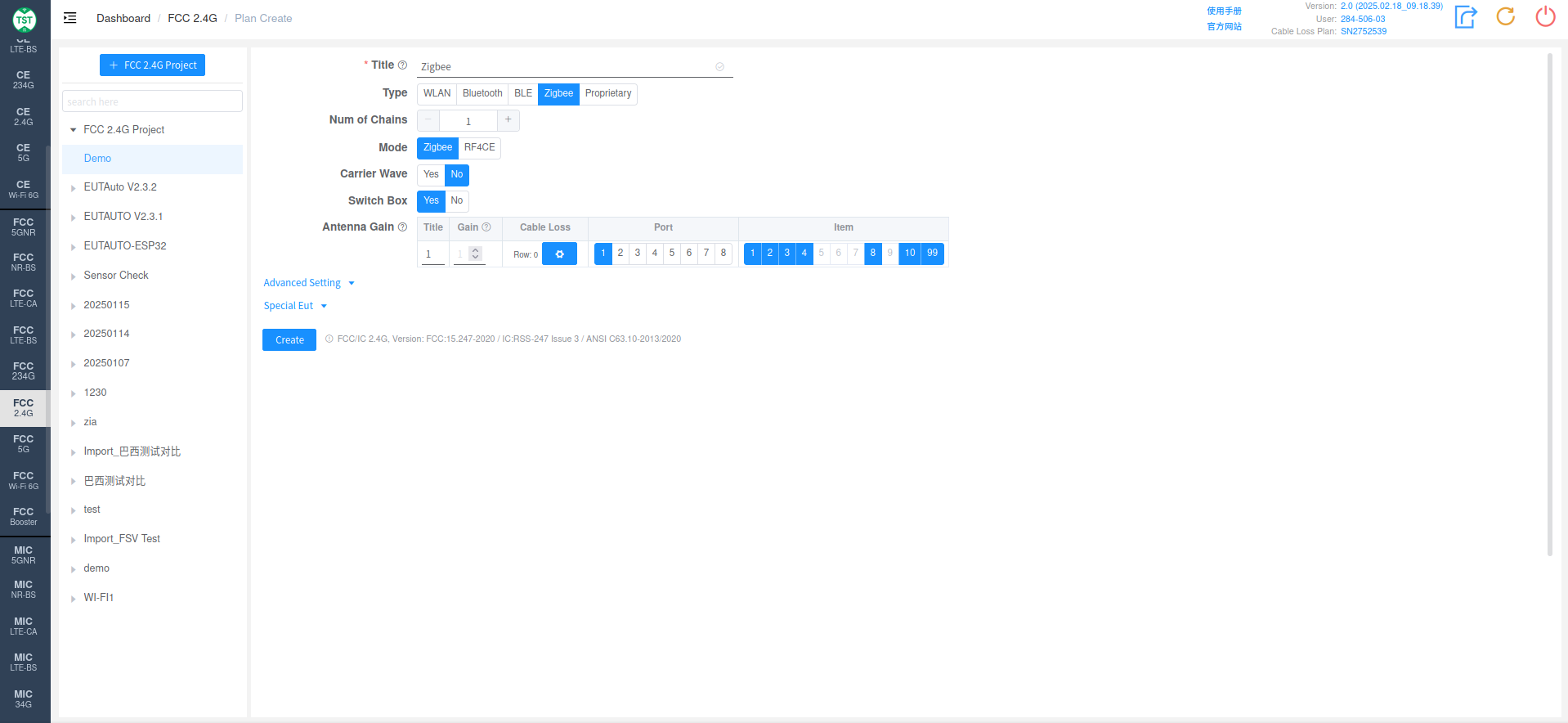
Type: Technical Category, Zigbee
Num of Chains: Number of transmit chains (antennas) the product has.
Mode: Modes supported by the product. Zigbee or RF4CE
Carrier Wave: Whether the product supports carrier wave transmission. If Yes is selected, the frequency error will be measured using carrier mode, and the test setup will be significantly different from modulated signal testing.
Switch Box: Whether to use a Switch Box. If a Switch Box has not been purchased, select No for this item, and the product will be directly connected to the spectrum analyzer for testing.
Antenna Gain:
Title: Antenna number, named sequentially by default as 1, 2, 3, 4..., or manually input other names according to customer requirements.
Gain: Gain of each antenna in the corresponding frequency band.
Cable Loss: Cable loss of the RF cable from the product's antenna port to the Switch Box (RF port of the switch) or SA (Spectrum Analyzer, if not using a switch directly). How to Create Common Cable Loss.
Port: Port number of the switch connected to the product's antenna, e.g., Ant1 connected to port 1, Ant2 connected to port 2.
Item: List of all test items included in this standard. *For known product types such as WIFI, Bluetooth, BLE, Zigbee, etc., the software has selected the default required test items based on their respective technical characteristics. Of course, you can also select some items for testing according to your testing needs. Note: In some standards, test parameters are mutually referenced between items. If only some items are checked, the test may not be able to proceed. Therefore, it is recommended to create a test plan using the default items directly. For multi-antenna products, to reduce workload, the first antenna will by default perform tests for all applicable items. However, other antennas have had some mandatory test items selected according to standard requirements. For non-mandatory items, you can check them yourself as needed.
Proprietary
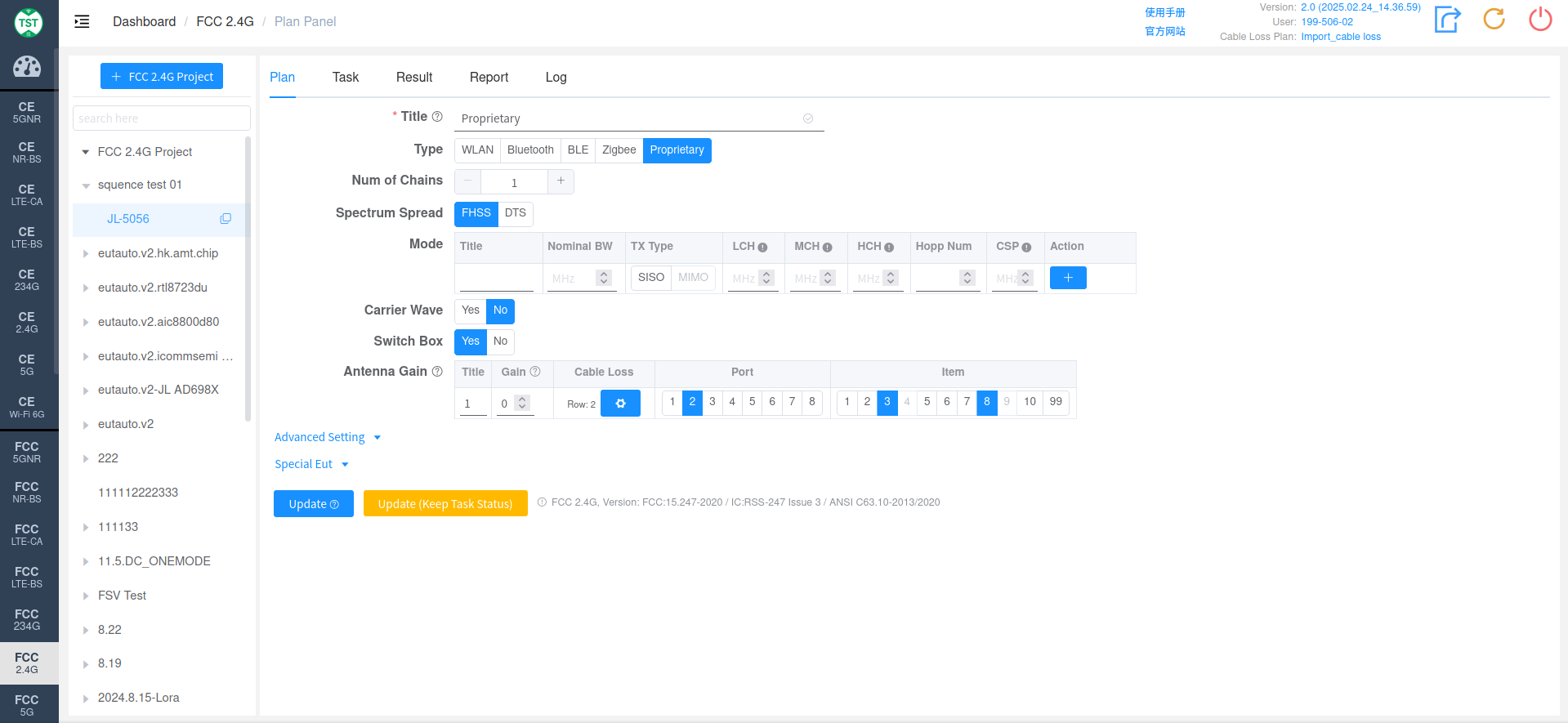
Type: Technical Category, Proprietary
Num of Chains: Number of transmit chains (antennas) the product has.
Spectrum Spread: Select the spectrum spreading method.
FHSS : Frequency Hopping Spread Spectrum. Transmits signals by rapidly switching (hopping) through a set of known frequencies, thus dispersing the signal across the spectrum. The advantage is reduced interference and improved security, as eavesdroppers find it difficult to lock onto and decode the signal without knowing the hopping sequence.
DTS : Systems using digital modulation techniques may operate in the 902-928 MHz, 2400-2483.5 MHz, and 5725-5850 MHz bands. The minimum 6 dB bandwidth shall be at least 500 kHz.
Mode:
Title: Mode number, manually input other names according to customer requirements.
Nominal BW: Set the predetermined bandwidth occupied by the signal on the spectrum.
TX Type: Set the transmission type.
SISO: Single Input Single Output. A basic wireless communication transmission method that uses a single antenna for transmitting and receiving.
MIMO: Multiple Input Multiple Output. This transmission method uses multiple antennas to transmit and receive data simultaneously, which can improve communication capacity and reliability.
LCH: Low Channel setting, used to specify the lowest frequency at which communication begins, in MHz.
MCH: Middle Channel setting, used to specify the center frequency of communication.
HCH: High Channel setting, used to specify the highest frequency of communication.
CSP: Channel Spacing, defines the frequency distance between channels. This is very important for broadband communication or devices where multiple channels operate simultaneously.
Action: Used to add new mode configurations.
Carrier Wave: Whether the product supports carrier wave transmission. If Yes is selected, the frequency error will be measured using carrier mode, and the test setup will be significantly different from modulated signal testing.
Switch Box: Whether to use a Switch Box. If a Switch Box has not been purchased, select No for this item, and the product will be directly connected to the spectrum analyzer for testing.
Antenna Gain:
Title: Antenna number, named sequentially by default as 1, 2, 3, 4..., or manually input other names according to customer requirements.
Gain: Gain of each antenna in the corresponding frequency band.
Cable Loss: Cable loss of the RF cable from the product's antenna port to the Switch Box (RF port of the switch) or SA (Spectrum Analyzer, if not using a switch directly). How to Create Common Cable Loss.
Port: Port number of the switch connected to the product's antenna, e.g., Ant1 connected to port 1, Ant2 connected to port 2.
Item: List of all test items included in this standard. *For known product types such as WIFI, Bluetooth, BLE, Zigbee, etc., the software has selected the default required test items based on their respective technical characteristics. Of course, you can also select some items for testing according to your testing needs. Note: In some standards, test parameters are mutually referenced between items. If only some items are checked, the test may not be able to proceed. Therefore, it is recommended to create a test plan using the default items directly. For multi-antenna products, to reduce workload, the first antenna will by default perform tests for all applicable items. However, other antennas have had some mandatory test items selected according to standard requirements. For non-mandatory items, you can check them yourself as needed.
Advanced Setting and Special Eut Settings:
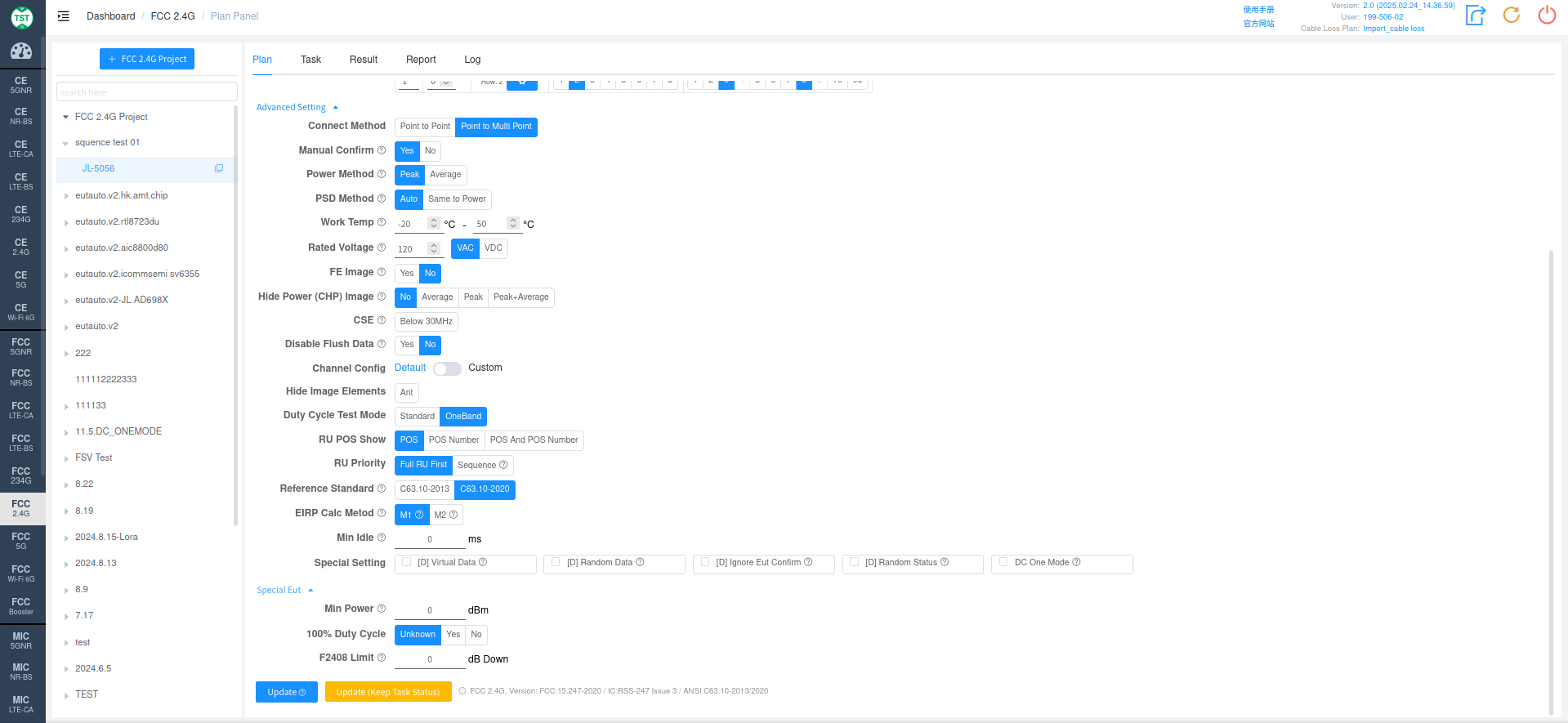
Special EUT里面的所有设定一般情况下不需要去设置,只有测试出来的结果异常时才需要设置
Connect Method: Confirm whether the product is P2P (Point to Point) or P2MP (Point to Multi Point), the default is P2MP. Common products are mostly P2MP, such as home routers, mobile phones, etc. If Antenna Gain or DG exceeds 6dB, this option will affect the calculation of conducted power limit reduction. For details, please refer to FCC Part 15.247 (c) eCFR Part 15.247
Ant Port RSE: Whether to perform antenna port spurious emissions testing. What is Antenna Port Spurious Emissions Testing.
External Filter: Whether an external filter will be used during antenna port spurious emissions testing.
Power Method: Confirm whether Conducted Power is measured using Peak or Average method.
PSD Method: Select the Power Spectral Density method, Auto (the test equipment will automatically select or adjust measurement parameters and methods according to regulations) or same to power (same as the measurement method of the total transmit power).
Work Temp: Enter the working temperature range of the product. Affects the measurement of frequency stability.
Rated Voltage: Enter the working voltage of the product. Affects the measurement of frequency stability.
FE Image: Whether to display the frequency stability test chart in the report, the default is No (not displayed).
Hide Power (CHP) Image: Hide the CHP report image option, applicable to reports of F2403 and F5005. Select whether to hide Average or Peak or Peak+Average. Click the hyperlink in the question mark to set the overall Hide Power (CHP) Image of the system.
CSE: Conducted Spurious Emissions involves measuring the spurious emissions of the device in different frequency bands. Below 30MHz needs to be tested: 9k ~ 150k / 150k
